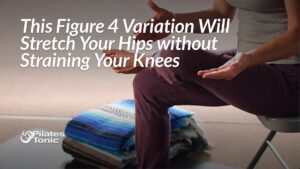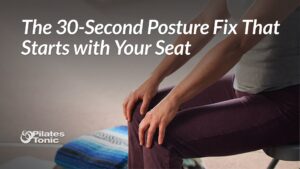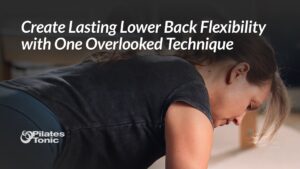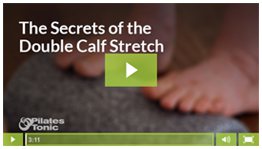Not only is today's video easy to add to your routine, it's also responsible for helping me make some of my most positive corrections to the muscle imbalances in my back.
My muscle imbalances are mostly related to scoliosis, but the way I used to hold my body made my scoliosis worse and I had no idea at the time.
But you don’t have to have scoliosis to have imbalances. Balance versus imbalance comes down to how you are using your body on a daily basis.
For instance, if you have the habit of standing shifted with your weight on your left leg, every time you stand in place talking with someone, or in line somewhere, you are unknowingly building up your left side, and weakening your right.
Another example is carrying a purse. If you always carry your purse over your right shoulder, its like going to the gym and only lifting weights with your right arm every time.
Would you go to a Pilates class and only practice standing balance on your left leg? When you think about it that way, it seems silly and obvious.
But that's exactly how our postural habits create muscle imbalances right under our nose!
We walk around completely clueless about our imbalances and as long as we are clueless, we can’t make changes to fix them.
But, once you discover an imbalance, you can begin to make the subtle shifts necessary to stop the progression and sometimes reverse the imbalance altogether!
The tool in today’s video focuses on imbalances in the back. Even if you're certain that you don’t have any imbalances in your back, I encourage you to watch the video. Even the most balanced folks may discover something they didn't know was causing trouble.
And if you already know you have an imbalance, definitely give today’s tool a try. It really made a difference for me and I'd love to hear that it did the same for you.
Just let me know in the comments below!
See you in the studio,
Sydney





8 Responses
Since the MJ workshop I attended last month, I’ve started using the SmartSpine wedge under the right side of my ribcage lying supine. Although I don’t have scoliosis, I do have a rotation where my ribs/thoracic region rotates to the right — most likely related to something else I was born with (pectus excavatum). Like you, this simple adjustment with the wedge has brought my body into a position where both sides are now “awake” and I can move more efficiently. A minor adjustment, but a big difference! Thanks for sharing as I think this has applications to scoliosis and beyond!
That’s fantastic Cailin! Thanks for sharing your feedback. 🙂
Hi Sydney, thank you so much for another of your wonderful videos! I find all them really useful and helpful for my own practice and teaching. The wedges are a great idea and I will give them a go! On the topic of spinal imbalance and going off at a slight tangent, I had my first ever craniosacral therapy session yesterday and am amazed at the results. What I’ve been trying to work on for years and with very limited success, the therapist managed to ‘fix’ in one very gentle treatment session. I’m not suggesting that I don’t have ongoing work or possibly treatment to do but for the first time in my memory, my right pelvis is not contorted to the left and I can sit or lie evenly on my sitbones at last! And my rib cage now faces forward instead of being twisted off to the left. Breathing feels easier. Wow! Not suggesting that this is the answer for everyone but thought I’d put it out there as it never occurred to me that someone had an answer like this for my issues!
Hi Kirsty, I’ve heard great things about craniosacral therapy, but have never tried it. You’ve piqued my interest for sure! Thanks you!
Hi Sydney, Have been really enjoying your informative website and such clear and wonderful education. Thank you for sharing your gift and insight. I’ve been working on rehab for many years trying to sought out my muscle/skeletal imbalances, and have unfortunately undergone spinal fusion surgery in addition to total hip replacement. I continue to have the same “twist” — and have been told I have a mild scoliotic curve (backwards C curve on the T spine is what appears most prominent). I’m wondering if when you put the spine triangle under your right spine where you feel the concavity, if you are are aiming more at the upper back (ribcage area) as opposed to the lumbar/pelvis region? when I lie down supine, I feel my “heavy” side is my right on the pelivs, but left on the thorax if that makes any sense. I also feel that in normal functioning, I am “twisted” with the thorax rotating to the right while the pelvis is opposing this and rotating left. Sorry so long on this comment, and appreciate!!
Hi Robyn, With scoliosis, in addition to the translation (or shift) of the spine to the side, there also comes a rotation, which will create the “twisted” feeling you describe. Here’s a couple things to try… First, when lying supine, use a pillow to create a ramp for your head, neck and shoulder girdle. Here’s a video that shows you how. Next, add a washcloth, or triangle under the side of your pelvis that feels heavier into the mat. Place it so that the pointy side is pointing out, or away from your body, and the wide portion is just under the side of your pelvis. This helps to correct the rotation, or twisted feeling. Lastly, add another triangle, or washcloth, on your concave side. This time with the pointy part pointed in toward your spine. Hope this helps. I’d love to hear how it goes! And thank you for your feedback and questions. I’m thrilled you are finding the website helpful!
Thanks so much Sydney. I will give the pelvic triangles a try for sure. Have worked with various wedging in the past, but never specifically this way. Usually in supine I’ve wedged my right ribs and left pelvis with foam wedges to try to achieve more neutral alignment. And I do love the gentle ramp as you’ve suggested and demonstrated (thank you- another great video) for my head/shoulders (slept this way last night and it seemed therapeutic). I am truly appreciative of your gift and wonderful resource in this website!!!
Thank you Robyn! I’d love to hear how it goes!